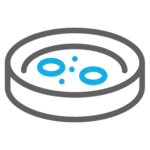Hi-C offers a unique and novel perspective missing from many of today’s epigenetic studies. The technology brings a new dimension to genomic research that cannot be captured with standard NGS approaches. Yet many consider the technique challenging due to the multiday workflow, complex experimental design, and non-traditional analytical approaches.
However, with technology advances culminating in the Dovetail® TopoLink™ Kit from Cantata Bio, the world of Hi-C is now easier than ever to explore. Here are five reasons why using Hi-C isn’t as hard as you might think and why you should consider adding it to your research toolbox.


Reason 1:
Sample Prep to Library in a Single Day
Most current Hi-C protocols require 2-4 days, splitting sample prep, proximity ligation, and library conversion across multiple days. This complex workflow introduces many opportunities for mistakes and errors to accumulate and requires users to block off the better part of a week to generate a library.
Without compromising data quality, the Dovetail® TopoLink™ workflow from sample to library can be completed in a single day.
Impact Spend less time at the bench, and more time focusing on your science.


Reason 2:
Sample Processing is Simplified
To call chromatin looping events, a traditional Hi-C experiment requires 3-4 proximity ligation reactions per sample. For a simple three-replicate, case/control study, that equates to up to 24 proximity ligation reaction tubes that must be processed. In addition, this significantly reduces the number of samples common commercial Hi-C Kits can support.
The Dovetail® TopoLink™ Kit is specifically configured to support loop calling studies for 4 samples. For each sample, a single proximity ligation reaction is sufficient to support the deep sequencing required.
Impact Simplify and streamline your experiments, making it even easier to integrate conformation data into your research.


Reason 3:
Make Better Use of Your Sequence Data
Hi-C data is notoriously noisy. Researchers using traditional Hi-C currently throw away up to 20% of their uniquely mapped sequence data as invalid Hi-C pairs. This is because Hi-C methods relying on restriction enzymes introduce non-informative artifacts that must be filtered out. The result is lower signal-to-noise and inefficient use of your sequencing budget.
By eliminating restriction enzyme use, the TopoLink™ Assay removes the most common source of invalid Hi-C pairs, enabling researchers to capture more chromatin features, with more evidence per feature.
Impact Improve the quality of your data sets while reducing sequencing cost.


Reason 4:
More Accurate Representation of the Biology
The reliance of traditional Hi-C on restriction enzymes for chromatin fragmentation introduces biases into the data. At a global level, this causes uneven sequence coverage, resulting in low—or even no—coverage for regions of interest to your research. Perhaps more concerning, even within regions of good coverage, signal can be artificially shifted due to fluctuations in restriction enzyme site density, potentially leading to erroneous conclusions.
The TopoLink workflow uses a sequence-independent fragmentation approach that ensures uniform sequence coverage and an unbiased view of chromatin interactions.
Impact Spend less time chasing down technical artifacts and have higher confidence in your results.


Reason 5:
Save Precious Sample
Hi-C experiments notoriously require large amounts of input material, anywhere from 2 – 10 million cells when loop calling. This can limit the scope of your study due to insufficient sample quantities. Sample pooling approaches to circumvent this limitation commonly confound results and complicate interpretation.
TopoLink requires as few as 500,000 cells to perform loop calling at 5-kb resolution, significantly less than alternative Hi-C approaches.
Impact Extend the life of your sample and increase the scope of your study.
Bring Hi-C Into Your Lab
The world of Hi-C has changed. It’s now within your grasp to bring Hi-C into your lab. Cantata Bio’s Dovetail® TopoLink™ Kit addresses the major pain points that have prevented researchers from incorporating 3D chromatin topology into their epigenetic studies.
Contact Us to Learn More!



